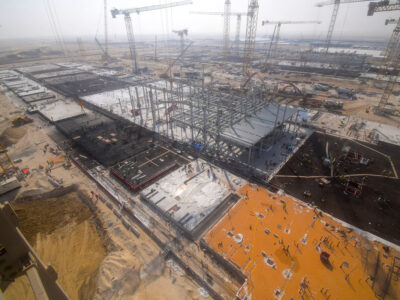After years of stagnation, the construction sector of Turkey has found a new sense of optimism, allowing it to post record growth rates in two successive years. Despite a relatively low public investment into infrastructure, the industry has grown on the back of a new national preoccupation: housing.
Between 1993 and 2003 the share of government orders shrunk from 60% to 45 % of the industry’s revenue base and many contractors and suppliers had to stop their activities or turn to international markets for survival.
In the last three years, economic stability, solid growth, lower currency exchange rates and lower interest rates on private savings doubled by more attractive bank loans offers, have all concurred to fuel the new growth in housing demand. The breakdown of construction activities in Turkey is a sign of the change: 60% is dedicated to housing needs, 25% to infrastructural projects and 15% to non-residential buildings.
Following the terrible August 1999 earthquake, which killed over 25,000 people in the Marmara region and in Istanbul, there has been a realisation that the housing stock was not only insufficient to accommodate the swelling number of urban dwellers and new young urban populations but also largely below safety norms as far as earthquake threats. Public anger was directed at architects, promoters and public authorities alike for their failing of the Turkish public.
Eight years on and the memory of this dark page of Turkey’s recent history is still alive, as is the knowledge that most of the country lies in highly seismic areas. Istanbul itself is said to have 50% possibility to witness a major earthquake (of magnitude seven or over) within the next two decades.
Meanwhile, over 40% of the city’s buildings are said to have been built without building authorisation or license. This, added to a steep climb in the urban life levels and a renewed sense of stability and confidence in the future, have all been converging factors for a sudden interest in new property developments.
In the last three years, Turkey’s urban centres, chiefly Istanbul, which holds an enormous potential for real estate development, but also Ankara and Izmir, have witnessed the mushrooming of apartment blocks and modern residences promising security, convenience and new ways of life for their prospective owners. And the market has responded well, with prices of real estate skyrocketing. Between 2005 and 2006, prices of housing units have increased by over 50% in Istanbul. Meanwhile, 500,000m² of shopping centres were under construction in the city.
Yet, one factor is still missing for the picture to be almost perfect: a functional mortgage system facilitating access to property for the Turkish population. This is about to be solved with the many-times-delayed, soon-to be announced new mortgage law. It is widely anticipated that with the key election due to take place this year in Turkey, the mortgage law will be announced as one of the main political pacifiers to be offered to voters by the outgoing government and legislature under the leadership of Recep Erdogan, the current prime minister.
Yet, risks are still running high, and many professionals in the sector remain sceptical as to whether the fundamentals of growth are to be trusted. For one thing, a mortgage system has not been formerly installed, and interest rates, despite a sharp decrease of housing rates in 2006, remain very high – today well over 20% yearly and swinging wildly. For another thing, most of the projects that have flourished in the urban centres of Turkey have been built at the initiative of construction-companies-turned-property developers.
Although it is difficult to measure the exact allocation between new dwellings and their expected clientele, early indications show that the match is not perfect yet as many of the new developments are rather addressing the higher ends of the market than the middle and lower segments, where most of the needs reside. The initiatives to address these categories’ needs have all been public, and very ambitious projects of social housings have come to tuition under the impulse of the government and local municipalities.
Designed to suppress slums and squalid housing projects, which have been home to a large part of the country’s many migrants and city dwellers, the Mass Housing Development Administration (TOKI) is an ambitious project launched by the current government to provide full mortgage funding opportunities to low-income families. The funding terms are very advantageous, with credit terms based on no down payment and a maturity term of 240 months. TOKIs aim is both to bring to the market 5-10% per year of the 2.5 million urgent housing needs of Turkey and to contribute to planned and organised urbanisation, a feature that has been neglected for many years in Turkey.
The programme stepped up its pace in recent years, and the construction of 250,000 new houses by the end of 2007 was announced, as the target of 200,000 new houses by the end of 2006 was nearly met.
These new units dedicated for the low income segment have spearheaded the mushrooming of social and housing project around the cities of Turkey. Meanwhile, despite the fact that allocation between higher-end new properties and potential buyers is being questioned, the appeal of Turkey for property developers remains certain.
From the country’s beautiful coast lines to Turkey’s urban centres, Istanbul in particular, there is plenty of room for investment. A sign of the attractiveness of the market is the strong display of interest by key international developers like Emirates and world’s largest property developer Emaar, who has entered Turkey with a high profile corporate marketing campaign and a few impressive figures of investment pledges for the Turkish market.
The Lakeside housing project was for instance initially presented as a US $700 million initial investment to be followed by a further $5-10 billion over the course of a few years, for a high luxury housing complex in a quiet and lush hill of Istanbul. Recently, the company was outbid by a local industrial group for the purchase of a high value ($800 million) plot of land in Istanbul. Yet the company’s general manager is confident of the future value to be unlocked in the Turkish market: “We have identified Turkey in general, Istanbul in particular as a major growth area and a focus of our company’s international expansion. The demand for high-end properties and the lifestyle associated to this type of commercial offer is very appealing for an experienced developer like Emaar,” explains Ozan Balaban.
The presence of the company is also likely to lead the way for other major foreign developers to invest on the Turkish market. “We are glad to have established a major presence in Turkey ahead of many others. This also shows our strong commitment to developing our activities in this region and makes of this market a showcase of our international abilities,” adds Balaban.
With a ratio of only 3.5% of home loan to GNP, compared with an EU average of 39%, the potential for growth in the market is huge. Istanbul is the most attractive market in the country and should become one of the favourite investment destinations for local and international developers. Despite country-specific risks, the value to be unlocked from the Turkish real estate market is blatant, and should be a major point of attraction in the future.
The pursuit of the country’s socio-economic transformation will be visible in the transformation and the enhancement of the urban landscape and the bettering of life conditions for millions of Turkish citizens. It should also continue providing activity to the country’s many contractors, material suppliers and other construction industry’s stakeholders. In turn, it is hoped that public authorities and other stakeholders will take adequate steps to preserve the unique nature of cities like Istanbul, and the southern coasts, and avoid the mistakes made elsewhere in Europe.







